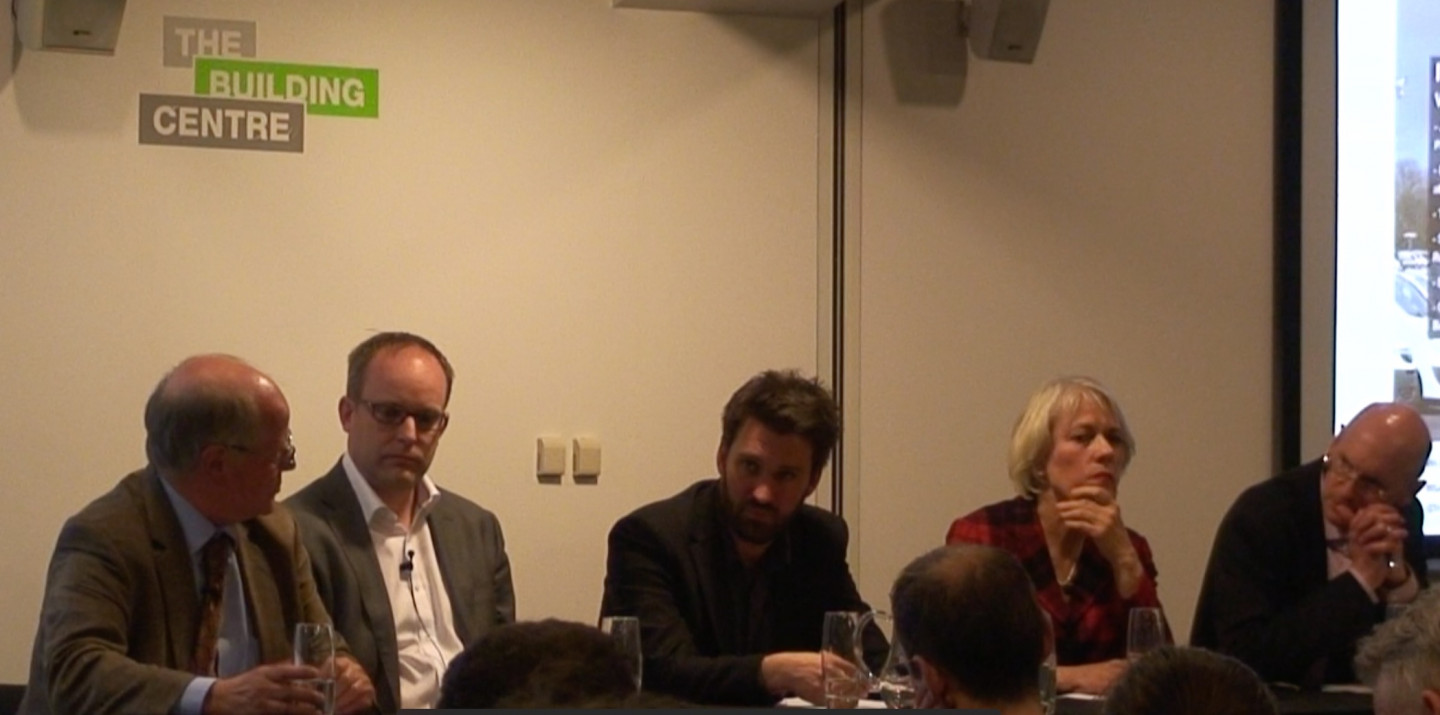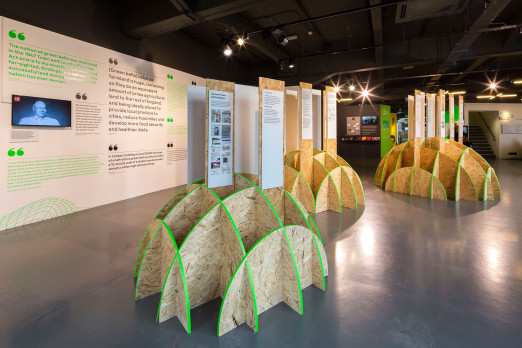In the second part of our feature on “Is the Green Belt luxury we can afford”, (click here for part one) Toby Lloyd, Head of Policy at Shelter, Barney Stringer, Director of Planning Consultancy at Quod, and Janet Askew, immediate past President at Royal Town Planning expand the often narrow, polarised debate around the green belt.
UK housing charity Shelter work at the edge of the housing crisis, where lack of affordable housing is played out on the streets of London every night. Toby Lloyd highlighted that there were “60,000 children homeless in London last Christmas and there are many, many causes, but at the heart is a lack of houses.”
Like Paul Cheshire, who highlighted that the market is not responding to market signals, Lloyd illustrated the scarcely believable mess we have got ourselves into with a graph that shows that as prices go through the roof, supply goes in the opposite direction.
(From the report When Brownfield Isn't Enough)
While there are many forces at work in the acceleration of the housing crisis, one of the most significant is the absence of a certain kind of economic and political actor – local authority supply. Lloyd argued that, “the real change happened in the 1980s when local authorities stopped building houses.”
So the question they set themselves is that we need 50,000 homes a year for the next eight years and where will we place them? Quod’s Barney Stringer took over to go through eight possible ways of addressing the crisis which they covered in their report When brownfield isn’t enough (click here to download) As Stringer explained, there is no ‘silver bullet’, we need a little bit of all of them, and they explored the many alternatives to green belt.
1. Brownfield is not empty land – it’s any land already developed
A lot of it is used for important things such as for public services – such as schools, mostly places where we work, it’s not empty waste land. We need to find ways of moving things. Developing brownfield sites is important - it is very difficult and very slow, and it takes time.
He pointed out that we have never built more than 18,000 private sector homes per year in London on brownfield. London is building 25,000 houses a year and we need another 25,000. To do those houses on brownfield alone it would take the equivalent size of the Olympic legacy scheme every 3-4 months, every year, on top of existing home building.
2. Building Tall, expanding upward densities, roughly 10 storeys or more
Contrary to conventional wisdom, London is not a low-rise city; medium high-rise is scattered all over London. Two-thirds of Londoners have a tall building within ten minutes walk, and two fifths of those are in outer London.
However, there are lots of restrictions on tall buildings. There isn't a free-for-all on tall buildings, but if this was the single solution, on top of all the building work being currently done we’d need 50 a storey tower built every three days.
3. Garden Cities, building whole new settlements
If we were going to build them, we’d have to build them far from London. Even the suggested example of Milton Keynes, at its peak, was building 2,700 homes a year, so to fill the current housing shortage we’d need 10 Milton Keyneses every year building at their peak rate.
4. Redevelopment, regeneration, estate renewal
Councils own a lot of land. A lot of it is not high density and could be improved. It is slow and expensive, but it can be done and most of all needs to be done properly. If you were to do this on its own, to deliver the extra 25,000 homes, you would need to demolish 25,000 social homes and build them at twice the density.
5. Densifying suburbs
A small increase in the density of suburbs would deliver a huge amount of housing, true but difficult to do – “Most people don’t like their semi-detacheds knocked down and replaced by flats.” Three flats, in fact, so to meet the current need, all the semi-detacheds built each year would have to be knocked down and replaced by three flats.
6. More housing around transport corridors especially as new infrastructure goes in.
The 20,000 homes from Crossrail 2 assumes some planning restriction changes, said Stringer. This takes a long time: the first version of Crossrail 1 was put to parliament in the 1880s and Crossrail 2 in 1904. These things in reality take a long time and aren’t cheap. It’s expensive: Crossrail costs £30 Billion and to solve the housing crisis would need to build one every eight years.
7. Redeveloping declining town centres.
The GLA has promoted this approach to improve housing capacity. Town centres are good places to build, retail is changing and town centres need reinvigorating. Outer London boroughs have been resisting, with concerns about building tall structures around lower rise buildings. To make those extra 25,000 dwellings you would need a 50 storey tower every other year in every one of London’s 221 town centres.
8. Green belt
To meet the eight years' worth of housing shortfall, you would need 0.8% of the metropolitan green belt.
All these solutions have political headaches attached to them. For politicians, which is the biggest headache? Perhaps the green belt seems easier for politicians, but for us, the best strategy is a little bit of everything - don’t rule anything out.
Needless to say, when they put the report out, the London Evening Standard newspaper ran the headline…
They concluded by arguing that we need to release small portions of green belt, but not allow cities to be hollowed out and not allow a planning free-for-all.
The most unusual aspect of final speaker Janet Askew’s presentation (Askew is immediate past-President at Royal Town Planning) was firstly her pitch that the green belt is a great British export, or at least the expertise and thinking around it has huge appeal for countries seeking solutions to the problems of urban development. We shouldn’t be surprised. As the UN’s World Urbanization Prospects report points out, “In 1950, 30 per cent of the world’s population was urban, and by 2050, 66 per cent of the world’s population is projected to be urban.” Secondly, her presentation unpacked the unintended social and human consequences of sprawl.
Askew argued that the green belt is a necessity not a luxury. While the housing problem must be addressed, building on the green belt is not the answer and in fact will create far more problems.
So while some say it is out of date, Askew underlined the history of the idea of the green belt, conceived simply to prevent urban sprawl, to check growth, to stop towns merging into each other, and to preserve the special character of the town. It has worked perfectly in Bath, an example of where the green belt is very successful.
Drawing on personal experience visiting working and lecturing other countries (she visited 15 countries) while President of the RTI, there was one enduring question – “how have you made a success of preventing sprawl?” As the UK questions the green belt, people overseas are asking how can we create it.
Askew pointed that Europe has urban sprawl problems. Though we think of Europe as having beautiful compact cities (and indeed there are many), in a report for the European Environment Agency in 2006 they called urban sprawl the ignored challenge. “Sprawl undermines the big challenge of climate change. It’s not sustainable. Report cites. Belgium, Germany, Ireland, coastal Spain.
The question is how do you service this random development and housing? Alternatives such as Green fingers in Copenhagen, and the Netherlands Green Heart, are under attack from similar pro-development privatisation assaults.
(Sketch from the first Finger Plan created by Denmark's Regional Planning Office in 1947. Click here to download Finger Plan: A Strategy for the Development of the Greater Copenhagen Area, 2015)
Additionally, in China, people are waking up to the consequences and disadvantages of limitless urban expansion and cities are being urged to densify, to stop spreading into farmland.
But the most effective warning around the increase in urban and suburban sprawl was the de-socialisation of older people and young families.
“Saving on housing costs is spent on increased travel costs, resulting in transport poverty”
Askew highlighted recent research by Professor Carolyn Whitman at The University of Melbourne which shows that social problems are worse at the edge rather than city centre. Melbourne has added 15 new suburbs since 2006, all further away from the centre. It’s partly due to poverty and unemployment – it can take three hours to get to work in Melbourne (download the e-book Melbourne: What Next?).
There are Canadian cities discussing this, while in Portland, Oregon, a ‘growth boundary’, has been established, which is a radical move in the US.
Regarding piggybacking housing onto new transport infrastructure, Askew noted US Research showing how money is lost the further out transport systems go, yet she points out how this seems to be something we are banking on to alleviate the crisis.
Plus there are increased car journeys on the edge. In Manchester, new research tracked elderly people being pushed to the edge over the last 20 years, far from facilities where you could walk to if you where in the city, and young families from facilities. Saving on housing costs is spent on increased travel costs, resulting in transport poverty.
We need more social housing, and a look at the impact of London’s success. The people who provide services – teachers, nurses, fireman – can’t live there.
It is easier to build on greenfield, but might be more expensive when developers are expected to provide infrastructure such as roads, schools and health centres. Brownfield may be cheap but we need incentives for brownfield, for dealing with issues such as land contamination.
She argued that we need to expand the success of London to the rest of the country, where there is no shortage of brownfield land in other cities, and we also need to build successful new towns such as Milton Keynes.
The perceived wisdom that the housing crisis is intractable (like the idea that poor people will always be with us) was shown by the speakers and the debate to be a kind of political and journalistic failure – a failure to communicate. What was compelling about the debate was the degree of specific, practical, creative propositions.
If the green belt is a problem in relation to the housing crisis it is simply because it is a red herring, a distraction, a means of avoiding doing the hard work. The green belt is clearly part of an on-going strategy, but we need to think of the the answer as less like a single solution game of Cluedo (“Colonel Mustard with the lead pipe left by the builders in the new extension”) and more like one of those Agatha Christie novels where everyone did it, where there are multiple actors. Politicians enjoy the immediate, linear, simple answer, and in the absence of engagement and good communication the general public also fail to see the real social opportunity in housing solutions that don't depend on greenbelt. The speakers at the event showed the potential rewards for new kinds of communities, new ways of living and new relationships with the landscape that can emerge from more of complex and fluid solutions to the housing crisis.
Beyond The Green Belt is a touring exhibition and talks programme made possible by the generous support and partnership of Pegasus Group and ACO Technologies.








